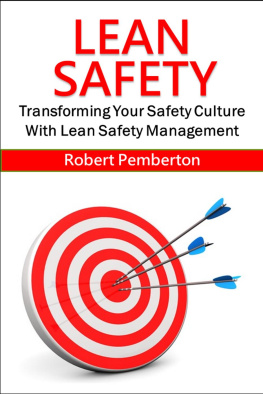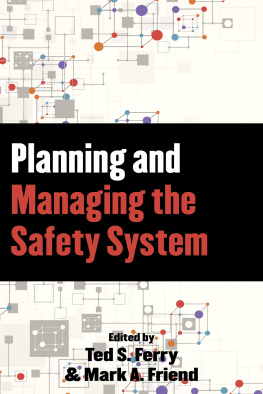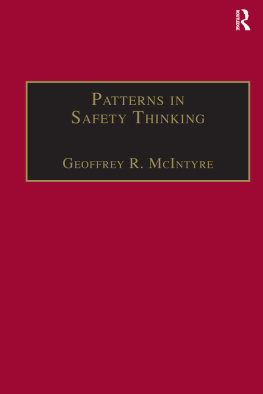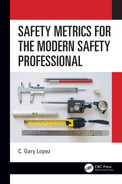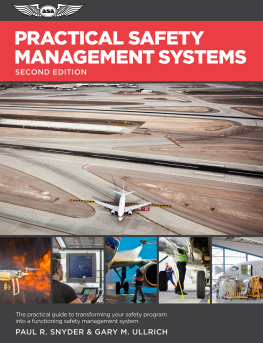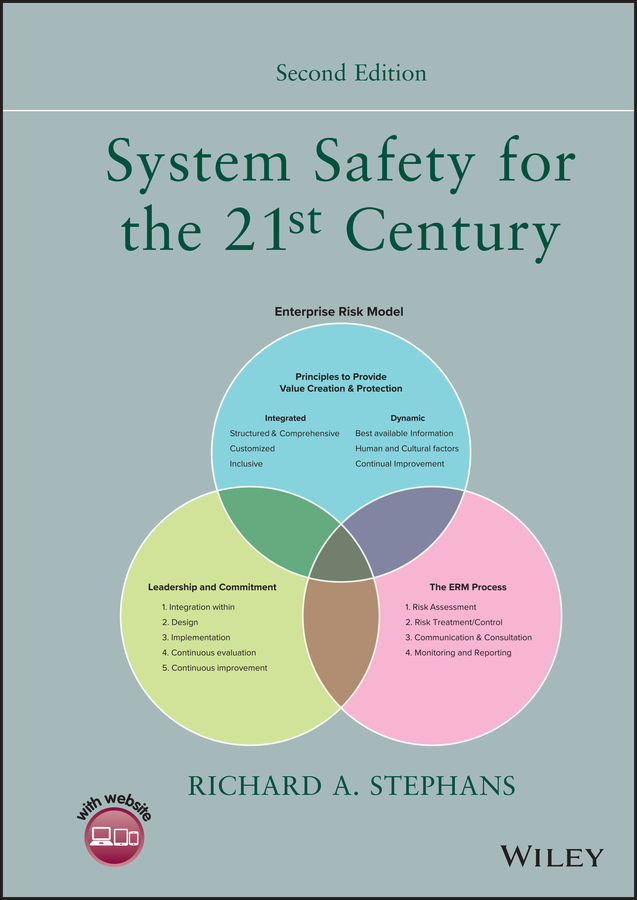Table of Contents
List of Tables
- Chapter 2
- Chapter 3
- Chapter 10
- Chapter 12
- Chapter 15
- Chapter 21
- Chapter 22
- Chapter 24
- Chapter 25
- Chapter 26
- Chapter 27
- Chapter 28
- Chapter 30
List of Illustrations
- Chapter 2
- Chapter 3
- Chapter 5
- Chapter 7
- Chapter 8
- Chapter 9
- Chapter 10
- Chapter 11
- Chapter 12
- Chapter 13
- Chapter 14
- Chapter 15
- Chapter 16
- Chapter 17
- Chapter 18
- Chapter 19
- Chapter 20
- Chapter 21
- Chapter 23
- Chapter 24
- Chapter 25
- Chapter 28
Guide
Pages
SYSTEM SAFETY FOR THE 21ST CENTURY
SECOND EDITION
Richard A. Stephans
Formerly ARES Corporation
Boulder City, USA

This edition first published 2022
2022 John Wiley & Sons, Inc.
Edition History
First Edition 2004 Wiley
All rights reserved. No part of this publication may be reproduced, stored in a retrieval system, or transmitted, in any form or by any means, electronic, mechanical, photocopying, recording, or otherwise, except as permitted by law. Advice on how to obtain permission to reuse material from this title is available at http://www.wiley.com/go/permissions.
The right of Richard A. Stephans to be identified as the author of this work has been asserted in accordance with law.
Registered Office
John Wiley & Sons, Inc., 111 River Street, Hoboken, NJ 07030, USA
Editorial Office
111 River Street, Hoboken, NJ 07030, USA
For details of our global editorial offices, customer services, and more information about Wiley products, visit us at www.wiley.com.
Wiley also publishes its books in a variety of electronic formats and by printondemand. Some content that appears in standard print versions of this book may not be available in other formats.
Limit of Liability/Disclaimer of Warranty
In view of ongoing research, equipment modifications, changes in governmental regulations, and the constant flow of information relating to the use of experimental reagents, equipment, and devices, the reader is urged to review and evaluate the information provided in the package insert or instructions for each chemical, piece of equipment, reagent, or device for, among other things, any changes in the instructions or indication of usage and for added warnings and precautions. While the publisher and authors have used their best efforts in preparing this work, they make no representations or warranties with respect to the accuracy or completeness of the contents of this work and specifically disclaim all warranties, including without limitation any implied warranties of merchantability or fitness for a particular purpose. No warranty may be created or extended by sales representatives, written sales materials, or promotional statements for this work. The fact that an organization, website, or product is referred to in this work as a citation and/or potential source of further information does not mean that the publisher and authors endorse the information or services the organization, website, or product may provide or recommendations it may make. This work is sold with the understanding that the publisher is not engaged in rendering professional services. The advice and strategies contained herein may not be suitable for your situation. You should consult with a specialist where appropriate. Further, readers should be aware that websites listed in this work may have changed or disappeared between when this work was written and when it is read. Neither the publisher nor authors shall be liable for any loss of profit or any other commercial damages, including but not limited to special, incidental, consequential, or other damages.
Library of Congress CataloginginPublication Data applied for:
ISBN: 9781119634751
Cover image: Courtesy of the author
Cover design by Wiley
FOREWORD
I just heard it again. A colleague of mine said that he has always taken the systems view with regard to system safety. I was once again surprised, shocked is probably a better word, that not everyone had that view. It reminded me that there remain varying views of the scope of system safety. The scope of the system safety discipline is broad, just like the industries that use the discipline. The system safety discipline has expanded well beyond the U.S. Department of Defense Community and U.S. borders. As such, its recognized discipline approach and broad scope are becoming better defined.
The International System Safety Society and most system safety professionals take a broad view of the scope of system safety, a system view. It considers the system safety discipline as analyzing all safety aspects for any size system (with a product being just a small system) throughout its entire life cycle. It uses a disciplined systems approach to manage safety risk by tapping into the known knowledge bases and using specific tools and techniques for analysis where knowledge bases do not exist or are insufficient for the technologies used in the system. Known knowledge bases include existing safety codes, safety standards, and lessons learned that have been developed in all technology areas. The system safety professional focuses more attention, however, where there are nonexistent or insufficient knowledge bases from which to draw upon. In this case, the system safety professional uses the specific tools and techniques available in the system safety profession to augment the lack of information in existing knowledge bases. The toplevel analyses identify where new safety requirements are necessary and where existing safety codes and standards can be used. The system safety discipline bridges the gap when existing knowledge bases are lacking and manages safety risks by identifying hazards from the known knowledge bases and the tools and techniques of this profession.
Because the system safety professional focuses more attention where there are no or insufficient knowledge bases, some in the industry perceive that the scope of the system safety discipline is just in those areas where little or no knowledge bases exist. However, the scope of the system safety discipline is much broader, and the system safety professional must have a complete understanding of how to use and apply the existing safety resources, in addition to when to use other system safety analyses to evaluate the entire system throughout its entire life cycle. Some colleagues refer to system safety as the umbrella safety since you must draw upon all safety resources for the technologies involved in the design. The system safety discipline has an established methodology and unique tools for analysis. It establishes acceptable levels of risk as part of the process and does not necessarily seek zero risk or rely only on checklists or standards. It considers rare events and lifecycle operations and analyzes both normal and abnormal circumstances. The discipline manages for success using training, independent assessments, management commitment, and lessons learned, and it plans for failure by establishing emergency response procedures, graceful degradation, surveillance, and maintenance.
This system safety discipline is unique because it addresses the safety of an entire system and its operations using existing knowledge bases and, where knowledge bases are insufficient, the tools of this profession. I am of the opinion that the methodology and tools of the system safety discipline should be applied to every system. I believe every company should develop and implement a system safety program that addresses the hazards in its organization, the products it purchases, and the systems that it designs and operates. Only the degree and depth of the system safety program will vary from system to system. As one colleague stated, I wouldnt spend too much time on the analysis of a paper clip. Using the system safety discipline, I am convinced that a company will apply its resources more effectively and achieve success in its ability to effectively manage safety risks.


